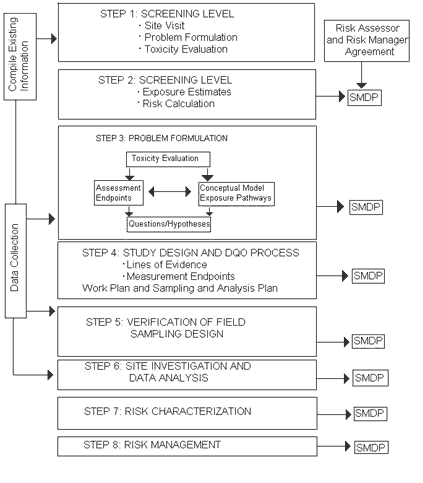Superfund Ecological Risk Assessment 8-Step
Process
In the Superfund program, Ecological Risk Assessments are done according
the Ecological Risk Assessment Guidance for Superfund (ERAGS). The following
diagram and table below are links to each of the eight-steps that are part
of this guidance (U.S. EPA, 1997, Ecological
Risk Assessment Guidance for Superfund: Process for Designing and Conducting
Ecological Risk Assessments, Interim Final, EPA 540-R-97-006. For more
details on any of these steps beyond what is presented on this website, click
above to download guidance document).
|
Steps 1 & 2 are considered to be part of
the Screening Level Ecological Risk Assessment |
|
1.
Screening-level problem formulation and toxicity evaluation |
- Problem formulation - information is gathered about
the site
- Site visit - investigators visit the site
- Ecological effects evaluation - review of scientific
literature to determine at what levels the chemicals present
will have adverse effects
|
|
|
- Estimating exposures - calculating how much plants
and animals are exposed to chemicals at the site;
- Risk calculation - calculation of Hazard
Quotients--the comparison of the levels of chemical contamination
at the the site to levels that are known to cause harm
|
|
Steps 3 to 7 are considered to be part of the
Baseline Ecological Risk Assessment |
|
|
|
- Refining Contaminants of Potential Ecological Concern
(COPECs) - deciding whether or not chemicals found at
the site should be considered further in determining potential
ecological risk
- Contaminant fate and transport - what happens to
the chemicals, biologically, chemically, physically and how
they move among plants and animals
- Mechanisms of toxicity - what are the harmful effects
on plants and animals
- Ecosystems potentially at risk - habitats and plants
and animals present; sensitivity by plants and animals to
chemicals; water bodies present
- Exposure pathways - how the chemicals pass through
the food web from the source of contamination
- Assessment endpoints - the characteristic(s) of a
plant or animal that can be measured in terms of harmful effects
- Conceptual site model - collection of exposure pathways
- Risk questions - using various lines of evidence,
answer the question "does chemical X cause harmful effects
in plant or animal Y?"
|
|
|
- Work plan and sampling plan - a written description
of how the investigation will proceed at the site
- Measurement endpoints - what is measured (i.e., reproduction,
mortality, growth, etc.) in relationship to the assessment
endpoints
- Study design - what type of testing will be done
to evaluate the potential ecological risk at the site
- Data quality objectives and statistical considerations
- a series of planning steps to insure the quality, type,
and quantity of data will be adequate and defendable
|
|
|
|
|
|
|
- Site investigation - the work as described in the
work plan is carried out
- Data analysis - the information gathered is analyzed
according to the work plan and statistical design
|
|
|
- Risk estimation and characterization - combining
the results of the studies performed to produce an estimate
of the ecological risk and describe that risk in terms of
extent, future potential for risk, how long might contamination
remain, and what are the prospects of natural recovery if
no action is taken
|
|
|
|
|
|
* These steps are followed by a Scientific
Management Decision Point (SMDP), during which it is decided
upon appropriate future courses of action, if any. |
Figure 1. Schematic Diagram of the Superfund Eight-Step Ecological
Risk Assessment (ERA) Process
Note: the diagram is an image map. Click on different
parts to go to separate pages on each step. (If the image map does not
load, click the 'reload' button on your browser.)

Note: SMDP is the abbreviation for "Scientific Management Decision Point"; these are points in the Ecological Risk Assessment process when the site
project manager and scientific advisors decide upon what additional steps, if any, are necessary to take.

![[logo] US EPA](../gif/logo_epaseal.gif)